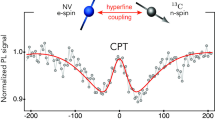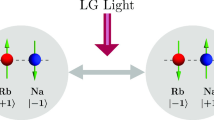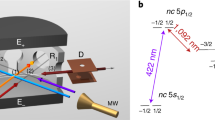Abstract
We review a few ideas and experiments that our laboratory in Korea University has proposed and carried out to use vector polarizability \(\beta \) to manipulate alkali-metal atoms. \(\beta \) comes from spin-orbit coupling, and it produces an ac Stark shift that resembles a Zeeman shift. When a circularly polarized laser field is properly detuned between the \(D_1\) and \(D_2\) transitions, an ac Stark shift of a ground-state atom takes the form of a pure Zeeman shift. We call it analogous Zeeman effect, and experimentally demonstrated optical Stern–Gerlach effect and an optical trap that behaves exactly like a magnetic trap. By tuning polarization of a trapping beam, and thereby controlling a shift proportional to \(\beta \), we demonstrated elimination of an inhomogeneous broadening of a ground hyperfine transition in an optical trap. We call it magic polarization. We also showed significant narrowing of a Raman sideband transition at a specific well depth. A Raman sideband in an optical trap is broadened owing to anharmonicity of the trap potential, and the broadening can be eliminated by \(\beta \)-induced differential ac Stark shift at a magic well depth. Finally, we proposed and experimentally demonstrated a cooling scheme that incorporated the idea of velocity-selective coherent population trapping to Raman sideband cooling to enhance cooling efficiency of the latter outside the Lamb–Dicke regime. We call it motion-selective coherent population trapping, and \(\beta \) is responsible for the selectivity. We include as a Supplementary Material a program file that calculates both scalar and vector polarizabilities of a given alkali-metal atom when wavelength of an applied field is specified. It also calculates depth of a potential well and photon-scattering rate of a trapped atom in a specific ground state when power, minimum spot size, and polarization of a trap beam are given.









Similar content being viewed by others
References
D. Cho, Analogous Zeeman effect from the tensor polarizability in alkali atoms. J. Korean Phys. Soc. 30, 373 (1997)
C.Y. Park, H. Noh, C.M. Lee, D. Cho, Measurement of the Zeeman-like ac Stark shift. Phys. Rev. A. 63, 032512 (2001). https://doi.org/10.1103/PhysRevA.63.032512
C.Y. Park, J.Y. Kim, J.M. Song, D. Cho, Optical Stern-Gerlach effect from the Zeeman-like ac Stark shift. Phys. Rev. A. 65, 033410 (2002). https://doi.org/10.1103/PhysRevA.65.033410
K.L. Corwin, S.J.M. Kuppens, D. Cho, C.E. Wieman, Spin-polarized atoms in a circularly polarized optical dipole trap. Phys. Rev. Lett. 83, 1311 (1999). https://doi.org/10.1103/PhysRevLett.83.1311
J.M. Choi, D. Cho, Elimination of inhomogeneous broadening for a ground-state hyperfine transition in an optical trap. J. Phys. Conf. Ser. 80, 012037 (2007). https://doi.org/10.1088/1742-6596/80/1/012037
H. Kim, H.S. Han, D. Cho, Magic polarization for optical trapping of atoms without Stark-induced dephasing. Phys. Rev. Lett. 111, 243004 (2013). https://doi.org/10.1103/PhysRevLett.111.243004
M.H. Seo, S. Park, D. Cho, Relaxation of atomic temperature anisotropy in a one-dimensional optical lattice enhanced by dynamic control of the aspect ratio. Phys. Rev. A 101, 043611 (2020). https://doi.org/10.1103/PhysRevA.101.043611
H.G. Lee, S. Park, M.H. Seo, D. Cho, Motion-selective coherent population trapping for subrecoil cooling of optically trapped atoms outside the Lamb-Dicke regime. Phys. Rev. A 106, 023324 (2022). https://doi.org/10.1103/PhysRevA.106.023324
S. Park, M.H. Seo, R.A. Kim, D. Cho, Motion-selective coherent population trapping by Raman sideband cooling along two paths in a \(\Lambda \) configuration. Phys. Rev. A. 106, 023323 (2022). https://doi.org/10.1103/PhysRevA.106.023323
A. Khadjavi, A. Lurio, W. Happer, Stark effect in the excited states of Rb, Cs, Cd, and Hg\(^\ast \). Phys. Rev. 167, 128 (1968). https://doi.org/10.1103/PhysRev.167.128
G. Racah, Theory of complex spectra II. Phys. Rev. 62, 438 (1942). https://doi.org/10.1103/PhysRev.62.438
A.R. Edmonds, Angular momentum in quantum mechanics (Princeton University Press, Princeton, New Jersey, 1960), p.75
Z.T. Lu, K.L. Corwin, M.J. Renn, M.H. Anderson, E.A. Cornell, C.E. Wieman, Low-velocity intense source of atoms from a magneto-optical trap. Phys. Rev. Lett. 77, 3331 (1996). https://doi.org/10.1103/PhysRevLett.77.3331
R.J. Cook, Optical Stern-Gerlach effect. Phys. Rev. A. 35, 3844 (1987). https://doi.org/10.1103/PhysRevA.35.3844
T. Sleator, T. Pfau, V. Balykin, O. Carnal, J. Mlynek, Experimental demonstration of the optical Stern-Gerlach effect. Phys. Rev. Lett. 68, 1996 (1992). https://doi.org/10.1103/PhysRevLett.68.1996
M. Karski, L. Förster, J.M. Choi, A. Steffen, W. Alt, D. Meschede, A. Widera, Quantum walk in position space with single optically trapped atoms. Science 325, 174 (2009). https://doi.org/10.1126/science.1174436
M. Anderlini, P.J. Lee, B.L. Brown, J. Sebby-Strabley, W.D. Phillips, J.V. Porto, Controlled exchange interaction between pairs of neutral atoms in an optical lattice. Nature 448, 452 (2007). https://doi.org/10.1038/nature06011
J.Y. Kim, J.S. Lee, J.H. Han, D. Cho, Optical dipole trap without inhomogeneous ac Stark broadening. J. Korean Phys. Soc. 42, 483 (2003)
S. Kuhr, W. Alt, D. Schrader, I. Dotsenko, Y. Miroshnychenko, A. Rauschenbeutel, D. Meschede, Analysis of dephasing mechanisms in a standing-wave dipole trap. Phys. Rev. A. 72, 023406 (2005). https://doi.org/10.1103/PhysRevA.72.023406
A. Kaplan, M.F. Andersen, N. Davidson, Suppression of inhomogeneous broadening in rf spectroscopy of optically trapped atoms. Phys. Rev. A. 66, 045401 (2002). https://doi.org/10.1103/PhysRevA.66.045401
A.G. Radnaev, Y.O. Dudin, R. Zhao, H.H. Jen, S.D. Jenkins, A. Kuzmich, T.A.B. Kennedy, A quantum memory with telecom-wavelength conversion. Nat. Phys. 6, 894 (2010). https://doi.org/10.1038/NPHYS1773
Y. Sagi, I. Almog, N. Davidson, Process tomography of dynamical decoupling in a dense cold atomic ensemble. Phys. Rev. Lett. 105, 053201 (2010). https://doi.org/10.1103/PhysRevLett.105.053201
N. Davidson, H.J. Lee, C.S. Adams, M. Kasevich, S. Chu, Long atomic coherence times in an optical dipole trap. Phys. Rev. Lett. 74, 1311 (1995). https://doi.org/10.1103/PhysRevLett.74.1311
V.V. Flambaum, V.A. Dzuba, A. Derevianko, Magic frequencies for cesium primary-frequency standard. Phys. Rev. Lett. 101, 220801 (2008). https://doi.org/10.1103/PhysRevLett.101.220801
M.S. Safronova, U.I. Safronova, C.W. Clark, Magic wavelengths for optical cooling and trapping of lithium. Phys. Rev. A. 86, 042505 (2012). https://doi.org/10.1103/PhysRevA.86.042505
H.S. Han, H.G. Lee, D. Cho, Site-specific and coherent manipulation of individual qubits in a 1D optical lattice with a 532-nm site separation. Phys. Rev. Lett. 122, 133201 (2019). https://doi.org/10.1103/PhysRevLett.122.133201
K. Kwon, K. Kim, J. Hur, S. Huh, J. Choi, Site-resolved imaging of a bosonic Mott insulator of \(^7\)Li atoms. Phys. Rev. A. 105, 033323 (2022). https://doi.org/10.1103/PhysRevA.105.033323
A. Derevianko, Theory of magic optical traps for Zeeman-insensitive clock transitions in alkali-metal atoms. Phys. Rev. A 81, 051606(R) (2010). https://doi.org/10.1103/PhysRevA.81.051606
C. Monroe, D.M. Meekhof, B.E. King, S.R. Jefferts, W.M. Itano, D.J. Wineland, P. Gould, Resolved-sideband Raman cooling of a bound atom to the 3D zero-point energy. Phys. Rev. Lett. 75, 4011 (1995). https://doi.org/10.1103/PhysRevLett.75.4011
A. Aspect, E. Arimondo, R. Kaiser, N. Vansteenkiste, C. Cohen-Tannoudji, Laser cooling below the one-photon recoil energy by velocity-selective coherent population trapping. Phys. Rev. Lett. 61, 826 (1988). https://doi.org/10.1103/PhysRevLett.61.826
H. Kim, H.S. Han, T.H. Yoon, D. Cho, Coherent population trapping in a \(\Lambda \) configuration coupled by magnetic dipole interactions. Phys. Rev. A. 89, 032507 (2014). https://doi.org/10.1103/PhysRevA.89.032507
L. Anderegg, B.L. Augenbraun, Y. Bao, S. Burchesky, L.W. Cheuk, W. Ketterle, J.M. Doyle, Laser cooling of optically trapped molecules. Nat. Phys. 14, 890 (2018). https://doi.org/10.1038/s41567-018-0191-z
Acknowledgements
This work was supported by the National Research Foundation of Korea (Grant No. NRF-2022R1F1A1075131).
Author information
Authors and Affiliations
Corresponding author
Additional information
Publisher's Note
Springer Nature remains neutral with regard to jurisdictional claims in published maps and institutional affiliations.
Appendix A: Numerical calculation of scalar and vector polarizabilities
Appendix A: Numerical calculation of scalar and vector polarizabilities
In the Excel file of the Supplementary Material, to obtain numerical values of \(\alpha \) and \(\beta \), we use the definitions in Eqs. (8) and (9), respectively, including the off-resonant terms. Those terms are not negligible when a trap beam is far detuned. When the principal quantum number of the ground state of an alkali-metal atom is n, we include couplings to only the \(nP_{J^\prime }\) and \((n+1)P_{J^\prime }\) states with \(J^\prime =1/2,3/2\). To obtain numerical values of a and b, we use Eqs. (19) and (20), respectively, and restrict the sums to \(n^\prime =n\). Since we consider a far-detuned trap beam, either ground or excited state hyperfine splitting is not important, and effect of an isotope shift is negligible too.
There are two definitions for a reduced matrix element commonly used in literature. We follow that of Racah [11], according to which the Wigner–Eckart theorem is written as [12]
and the reduced matrix element for an electric dipole moment between the \(|n^\prime P_{J^\prime } \rangle \) and \(|nS_{1/2} \rangle \) states of an alkali-metal atom is related to the lifetime \(\tau (n^\prime P_{J^\prime })\) by
where \(\omega _0\) is the \(|nS_{1/2} \rangle \) \(\rightarrow \) \(|n^\prime P_{J^\prime } \rangle \) transition frequency. For spectroscopic data, we use NIST Atomic Spectra Database Lines Data [13], where Einstein coefficient \(A(n^\prime P_{J^\prime }) = 1/\tau (n^\prime P_{J^\prime })\) of the upper state \(|n^\prime P_{J^\prime } \rangle \) and wavelength \(\lambda _0 = 2\pi c /\omega _0\) are tabulated.
In the Excel file, for a given wavelength \(\lambda \) of a trap beam, \(\alpha , \beta \) and a, b are calculated in atomic units. For given power P, minimum spot size \(w_0\) (\(e^{-2}\) intensity radius), and degree of circularity \(\eta \) of the trap beam, well depth \(U_\textrm{AC}(F,m_F)\) for the ground hyperfine state \(|nS_{1/2}, F, m_F \rangle \) according to Eq. (10) is given in mK:
A photon-scattering rate \(R_\gamma (F,m_F)\) according to Eq. (18) is given in s\(^{-1}\):
where we use \(\Gamma = A(nP_{1/2})\) of the \(D_1\) transition.
Rights and permissions
Springer Nature or its licensor (e.g. a society or other partner) holds exclusive rights to this article under a publishing agreement with the author(s) or other rightsholder(s); author self-archiving of the accepted manuscript version of this article is solely governed by the terms of such publishing agreement and applicable law.
About this article
Cite this article
Cho, D. Use of vector polarizability to manipulate alkali-metal atoms. J. Korean Phys. Soc. 82, 864–874 (2023). https://doi.org/10.1007/s40042-023-00776-z
Received:
Revised:
Accepted:
Published:
Issue Date:
DOI: https://doi.org/10.1007/s40042-023-00776-z




